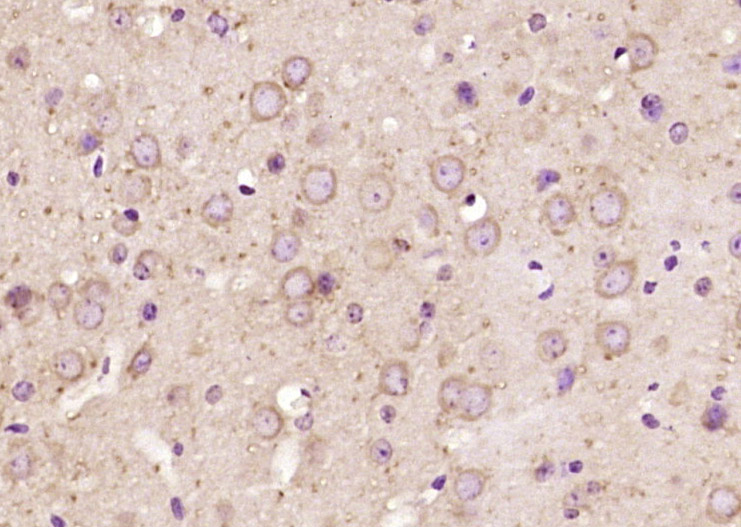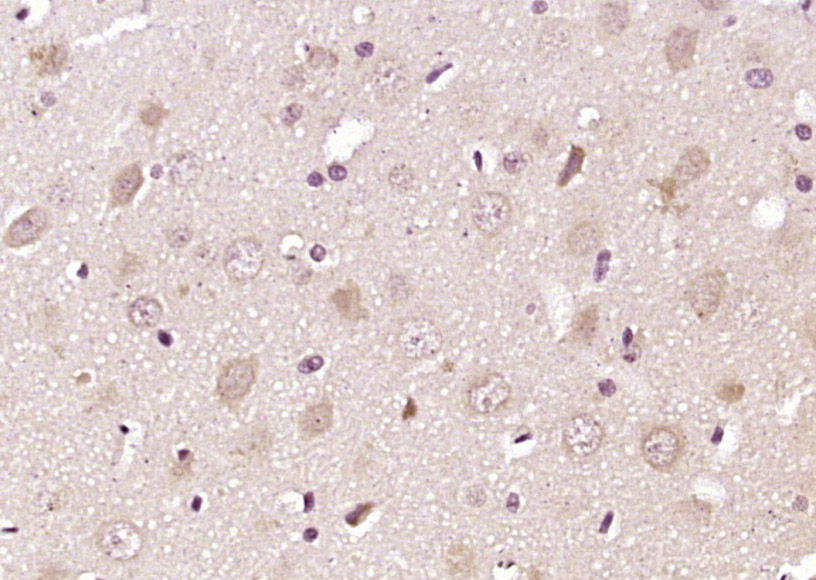
Rabbit Anti-PIP5KL1 antibody
bA203J24.5; EC 2.7.1.68; MGC46424; phosphatidylinositol 4 phosphate 5 kinase like 1; phosphatidylinositol phosphate kinase homolog; Phosphatidylinositol-4-phosphate 5-kinase-like protein 1; PI(4)P 5 kinase like protein 1; PI(4)P 5-kinase-like protein 1; P
View History [Clear]
Details
Product Name PIP5KL1 Chinese Name 4-磷酸磷脂酰肌醇5激酶1样蛋白抗体 Alias bA203J24.5; EC 2.7.1.68; MGC46424; phosphatidylinositol 4 phosphate 5 kinase like 1; phosphatidylinositol phosphate kinase homolog; Phosphatidylinositol-4-phosphate 5-kinase-like protein 1; PI(4)P 5 kinase like protein 1; PI(4)P 5-kinase-like protein 1; PI5L1_HUMAN; PIP5KL1; PIPKH; PtdIns(4)P 5 kinase like protein 1; PtdIns(4)P-5-kinase-like protein 1. Research Area Tumour Cell biology Signal transduction Cytoskeleton Immunogen Species Rabbit Clonality Polyclonal React Species Mouse, Rat, (predicted: Human, Dog, Cow, Horse, Rabbit, ) Applications ELISA=1:5000-10000 IHC-P=1:100-500 IHC-F=1:100-500 ICC=1:100-500 IF=1:100-500 (Paraffin sections need antigen repair)
not yet tested in other applications.
optimal dilutions/concentrations should be determined by the end user.Theoretical molecular weight 45kDa Cellular localization cytoplasmic The cell membrane Form Liquid Concentration 1mg/ml immunogen KLH conjugated synthetic peptide derived from human PIP5KL1: 101-220/394 Lsotype IgG Purification affinity purified by Protein A Buffer Solution 0.01M TBS(pH7.4) with 1% BSA, 0.03% Proclin300 and 50% Glycerol. Storage Shipped at 4℃. Store at -20 °C for one year. Avoid repeated freeze/thaw cycles. Attention This product as supplied is intended for research use only, not for use in human, therapeutic or diagnostic applications. PubMed PubMed Product Detail PIPKH, also known as PIP5KL1 (phosphatidylinositol-4-phosphate 5-kinase-like 1), is a 394 amino acid phosphoinositide kinase-like protein that contains one PIPK domain. Although PIPKH lacks intrinsic lipid kinase activity, it associates with type I PIPKs and may play a role in localization of PIPK activity. Encoded by a gene that maps to human chromosome 9q34.11, PIPKH localizes to cytoplasm, specifically to large cytoplasmic vesicular structures, and exists as two alternatively spliced isoforms. Highly expressed in brain and testis, PIPKH is also expressed at very low levels in heart, spleen, lung, liver, skeletal muscle and kidney. PIPKH heterodimerizes with other type I phosphatidylinositol-4-phosphate 5-kinases, and may function as a scaffold to localize and regulate kinases to specific cell compartments. Overexpression of PIPKH may suppress cell proliferation and migration in human gastric cancer cells and may also inhibit cervical cancer formation.
Function:
May act as a scaffold to localize and regulate type I PI(4)P 5-kinases to specific compartments within the cell, where they generate PI(4,5)P2 for actin nucleation, signaling and scaffold protein recruitment and conversion to PI(3,4,5)P3.
Subunit:
Heterodimerizes with other type I phosphatidylinositol 4-phosphate 5-kinase.
Subcellular Location:
Cytoplasm. Membrane. Note=Localized to large cytoplasmic vesicular structures.
Similarity:
Contains 1 PIPK domain.
SWISS:
Q5T9C9
Gene ID:
138429
Database links:Entrez Gene: 138429 Human
Omim: 612865 Human
SwissProt: Q5T9C9 Human
Unigene: 445486 Human
Unigene: 734928 Human
Product Picture
Partial purchase records(bought amounts latest0)
No one bought this product
User Comment(Total0User Comment Num)
- No comment




 +86 571 56623320
+86 571 56623320




